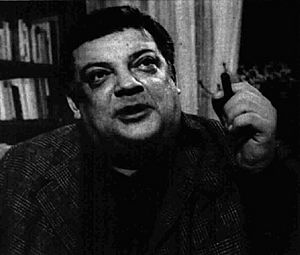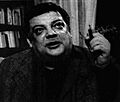Bruno Maderna facts for kids
Bruno Maderna (born April 21, 1920 – died November 13, 1973) was a famous Italian conductor and composer. He was known for his modern music and for leading many orchestras around the world.
Life Story
Bruno Maderna was born Bruno Grossato in Venice, Italy. He later chose to use his mother's last name, Maderna. He started learning the violin at age four with his grandfather. He once said that playing the violin could help you do anything!
As a child, Bruno was a musical genius. He played many instruments like the violin, drums, and accordion in his father's small band. In his early teens, he was not only playing violin concertos but also leading orchestras. He conducted famous groups like the orchestra of La Scala in Milan.
When he was four, a kind woman named Irma Manfredi adopted him. She made sure he got a great music education. He took private lessons in music theory and composition. He also studied at the Rome Conservatory and the Benedetto Marcello Conservatory in Venice. He learned conducting from famous teachers like Antonio Guarnieri and Hermann Scherchen. From Scherchen, he learned about a modern music style called twelve-tone technique.
During World War II, Bruno Maderna helped the Italian resistance movement. After the war, he taught music theory at the Venice Conservatory. He also worked on old Italian music with another composer, Gian Francesco Malipiero. During this time, he met many other important composers. These included Luigi Dallapiccola, Pierre Boulez, Olivier Messiaen, and Karlheinz Stockhausen.
Conductor and Teacher
In 1950, Bruno Maderna began his international career as a conductor. He led orchestras in cities like Paris and Munich, and all across Europe. In 1955, he started the Studio di fonologia musicale di Radio Milano with Luciano Berio. This was a place for electronic music. He also created "Incontri musicali," a concert series to share new music in Italy.
Maderna also spent time teaching music. He taught at the Milan Conservatory in Italy. He also lectured at the Dartington International Summer School in England. From 1961 to 1966, he and Pierre Boulez led the International Kranichsteiner Kammerensemble in Darmstadt. Even with all this work, Maderna still found time to compose his own music.
In the 1960s and 1970s, he spent a lot of time in the United States. He taught and conducted there. In 1971–72, he became the director of new music at Tanglewood. In 1972–73, he was the main conductor of the Orchestra Sinfonica of RAI in Milan.
Bruno Maderna died in Darmstadt in 1973 from lung cancer. He was 53 years old. Many composers wrote music to remember him. For example, Pierre Boulez wrote Rituel in memoriam Bruno Maderna.
His Music
Bruno Maderna wrote a lot of music in many different styles. He composed pieces for instruments, small groups (chamber music), and concertos. He also created electronic music. He wrote music for plays and radio shows, and he arranged old music.
Many of Maderna's important works are concertos. These are pieces for a solo instrument and an orchestra. He wrote concertos for violin, two pianos, and solo piano. He especially liked the oboe, writing three concertos for it. The first was in 1962–63, and two more in 1967 and 1973.
Other major orchestral works include Aura and Biogramma (both from 1967). He also wrote Quadrivium, a piece for four percussion players and four orchestral groups. His Requiem, a large musical work, was written between 1944 and 1946. It was rediscovered and performed again in 2009.
Maderna was also a key composer in electronic music and experimental music. His piece Musica su due dimensioni (Music in Two Dimensions) was for flute, cymbals, and tape. It was first played in 1952. This was one of the first times a composer mixed live sounds with electronic sounds.
Images for kids
See also
 In Spanish: Bruno Maderna para niños
In Spanish: Bruno Maderna para niños





